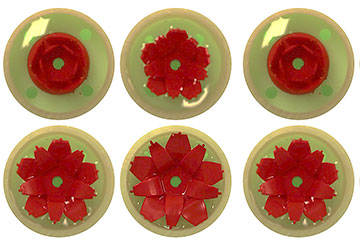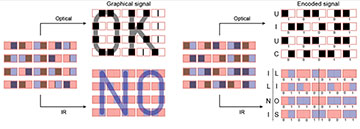
University of Illinois Urbana-Champaign engineers have developed a new breed of display screens that use flexible fins, varying temperatures and liquid droplets that can be arranged in various orientations to create images. The control is precise enough to achieve complex motions, like simulating the opening of a flower bloom. [Image: S. Tawfick]
Inspired by a chameleon’s color-changing skin, researchers in the United States say they have created a new type of reflective display that is 10 times more energy efficient than electronic paper (Sci. Adv., doi: 10.1126/sciadv.adh1321). The technology—named Polytexis—employs a combination of droplets of liquid, flexible fins and tiny mechanical pumps to produce switchable visual contrast.
Modeled on morphing skin
In general, reflective displays are much more energy efficient than light-emitting displays, since they leverage ambient light. They fall into two broad categories: flip-disc displays, found in train stations and stadiums, and electronic paper displays, used in e-readers such as Amazon’s Kindle. Combining his interest in elastocapillarity with soft robotics, Sameh Tawfick aimed to develop a third type that could mimic the morphing skin appendages found in nature.
“In the animal world, natural creatures use their skin as a display in functions like camouflage,” said study author Tawfick, a professor of mechanical science and engineering at the University of Illinois, Urbana-Champaign. “They typically display colors and patterns using fluidic chambers and muscles to push the colored fluid, like ink droplets, around.”
In particular, chameleons have layers of skin that contain specialized cells called chromatophores, which are filled with sacs of different kinds of pigment. When an animal experiences changes in body temperature or mood, certain chromatophores will expand or contract, creating the appearance of a color change on its skin.
Flexible, high-contrast fins
A schematic of the mechanism displaying simultaneous optical and infrared signals of the words “OK” and “NO.” In the graphic, cold pixels are indicated by a blue color and hot pixels are indicated by a pink color. [Image: S. Tawfick] [Enlarge image]
The Polytexis display is made up of cubic pixel boxes a few millimeters in size, each containing fins made of a flexible, high-contrast polymer. Mechanical pumps are used to secrete or retract a droplet of mineral oil through a pore at the bottom of the pixel box. Retraction causes the fin to be pulled down by capillarity until it becomes horizontal on the surface. It then stays in this position without power because of capillary adhesion—the same reason a glass cup sticks to a table when it is wet at the bottom.
“Due to the high contrast of the fin compared to the background, the horizontal state of the fin gives an ‘on’ display for each pixel,” Tawfick said. “On the other hand, the fin is invisible when it is vertical because it has a very small thickness, thus providing an ‘off’ signal.”
Varying the temperature of the droplet creates infrared patterns in addition to the optical reflective patterns, enabling optical/infrared multispectral signaling. The device can therefore send two simultaneous signals—one that can be seen with the human eye and another that can only be seen with an infrared camera.
Tawfick and his colleagues combined a 3 × 3 array of these cubic pixel boxes to construct a multimodal soft display panel. The dark blue color of the fin produced a reversible on/off contrast against a yellow background, and the prototype was able to form letters (e.g. UIUC). The refresh rate is about 1 frame per second, meaning potential applications for Polytexis would be limited to signage, such as billboards, stadium displays, train and bus station signs and building facades.
“We have developed a whole new breed of displays that require minimal energy, are scalable and even flexible enough to be placed onto curved surfaces,” said Tawfick.


